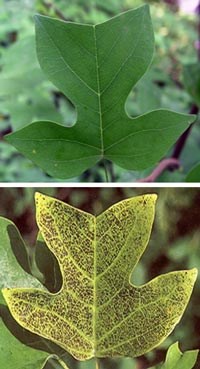
Ground-level ozone is one of the most widespread air pollutants. Naturally-occurring ozone in the upper atmosphere forms a layer that absorbs the sun's harmful ultraviolet rays and protects all life on earth. But, ground-level ozone can harm plants as well as human health. It does not come directly from smokestacks or vehicles, but instead is formed when other pollutants, mainly nitrogen oxides and volatile organic compounds, react in the atmosphere in the presence of sunlight. Ozone causes considerable damage to plants around the world, including agricultural crops and plants in natural ecosystems. Ozone damages plants by entering leaf openings called stomata and oxidizing (burning) plant tissue during respiration. This damages the plant leaves and causes reduced survival. Many factors can increase the amount of ozone injury such as soil moisture, presence of other air pollutants, insects or diseases, and other environmental stresses. Ozone effects on natural vegetation have been documented throughout the country, especially in many areas of the eastern U.S. and in California. Ozone gardens are one way that national parks are studying ozone effects on vegetation in collaboration with students and community groups. We monitor gound-level ozone in parks around the country and track park-specific information about ozone conditions and trends. NPS ozone risk assessments rank park risk according to pollutant exposure and ecosystem sensitivity (soil moisture and sensitive species). Some species are more sensitive to ground-level ozone than others. Search for a list of sensitive plant species by park. Also, learn how ozone affects tree growth. Learn more about the effects of air pollution in parks by visiting the Park Air Profiles pages or AQRV Inventory Products page. Research in Parks |
Last updated: August 11, 2025
